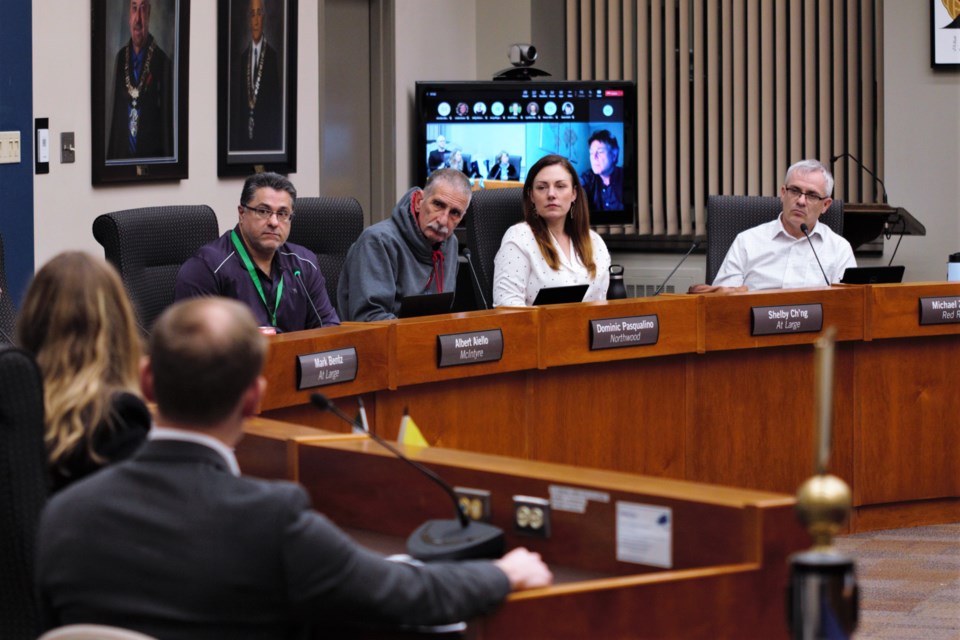THUNDER BAY — A six-member citizen committee will lead a review process that could dramatically reshape Thunder Bay’s city council in time for the next municipal election in 2026.
Nearly every defining charcteristic of council will be on the table: its size, councillors' part-time status and pay, the city's unusual hybrid model featuring both ward and at-large councillors — and, if wards are retained, where their boundaries lie.
On Monday, council approved terms of reference to guide the committee’s work over the coming year, based on recommendations from city clerk Krista Power.
The step came nearly three years after council, in its previous term, opened the door to changing its size and composition.
In an interview, Power called the review perhaps the most consequential work of her career.
“This is probably the most important project I will have worked on, because of how significant the outcome could be,” she said. “This could change the history of our city. This could change the representation for people who need to reach out about a matter in their neighbourhood, about a concern with the budget.”
The committee will be made up of five members appointed by council on Power’s recommendation, and one member appointed by the Thunder Bay Chamber of Commerce. Power said she will also recommend appointing a representative from the Thunder Bay and District Labour Council, leaving four citizen seats.
The city will launch a call for applications to serve on the committee in the coming weeks, seeking applicants with expertise in law or municipal legislation, political science, communications and citizen engagement, and the labour movement.
The committee is expected to deliver a report by the end of 2024 making specific recommendations on the number of councillors “that would best serve the City of Thunder Bay” and “the validity and rationale for a ward system with specific boundaries.”
Thunder Bay is believed to be unique in Ontario in its hybrid ward/at-large model. Many municipalities have councils entirely made up of ward councillors, while in others all are elected at-large.
Power suggested the city's hybrid model has offered governance benefits, balancing neighbourhood and city-wide priorities, but said it will be up to the public to weigh in on that question.
If the committee endorses significant changes to council’s composition, it’s also tasked with considering adjustments to how much councillors are paid, and potentially their part-time status. The mayor is the only council member considered to be full-time.
Ultimately, it will be up to the current city council to approve or reject the committee’s recommendations.
With any changes potentially impacting individual councillors' reelection chances, however, Power called it crucial that councillors were left off the committee that will shape those recommendations.
“Council is the decision-maker in this process — you will review the options, you will decide,” she said. “We didn’t want to muddy the waters by including members of council on the committee and potentially creating a lack of faith from community.”
The committee is directed to consider information from two rounds of public feedback, research on comparable municipalities, one-on-one interviews with sitting councillors, and factors like councillors’ workloads.
If the ward system is retained, Power anticipates changes to ward boundaries will be needed to address demographic changes since 1985, when the current model was set.
The number of eligible voters across the city’s seven wards swings from 7,613 people in Neebing to 15,234 in Red River, according to information provided by the city.
The city's population is distributed more evenly among the five other wards, which all contain between 10,000 and 13,700 voters.
While a review may look to smooth out those variations, Power said the exercise is far more than a numbers game.
"When we’re looking at ward boundaries, we’re not just looking at population, we’re also looking at what is appropriate representation to the area," she said. "We have some rural areas within the municipality of Thunder Bay, also not dividing neighbourhoods … We wouldn’t want to put a ward that divides the north core or the south core."
Any changes to ward boundaries would potentially be subject to appeal to the Ontario Land Tribunal — one of the reasons Power told council the review process should wrap well before the 2026 election.
While the idea of cutting council’s size has sometimes been pitched as a cost-cutting measure, Power called savings unlikely.
“People often assume if we were to cut council in half, that would save significant dollars,” she said. “In most cases, it wouldn’t, and we have data and statistics that prove that. If you look at what happened with the City of Toronto, they went from more than 40 councillors to 24 councillors, and their budget increased.”
If the committee proposes shrinking council, it could likely also consider higher pay for remaining councillors or providing more staff support, Power said.
The review committee will be appointed by August, according to a timeline presented Monday.
Initial public consultations are slated for the fall, followed by an interim report to council by January 2024, a second round of consultations that spring, and a final report to council by the end of 2024.
The review responds to a call to consider cutting council from 13 to nine seats made by Coun. Kristen Oliver in 2020. Oliver later amended her motion to request an open-ended review after some council opposition.
The review was initially intended to inform changes for the 2022 election, but was pushed back over concerns the COVID-19 pandemic would unacceptably limit consultation.
The city has always had a 13-member council, staff reported. When the municipality of Thunder Bay was created in 1970, it began with a mayor and 12 councillors elected evenly across four wards.
That expanded to seven wards in 1976, before the city in 1985 adopted its current hybrid system that elects a mayor, seven ward councillors, and five at-large councillors.
The council review is estimated to cost around $28,000, which staff said will largely fund advertising of public consultation opportunities.
